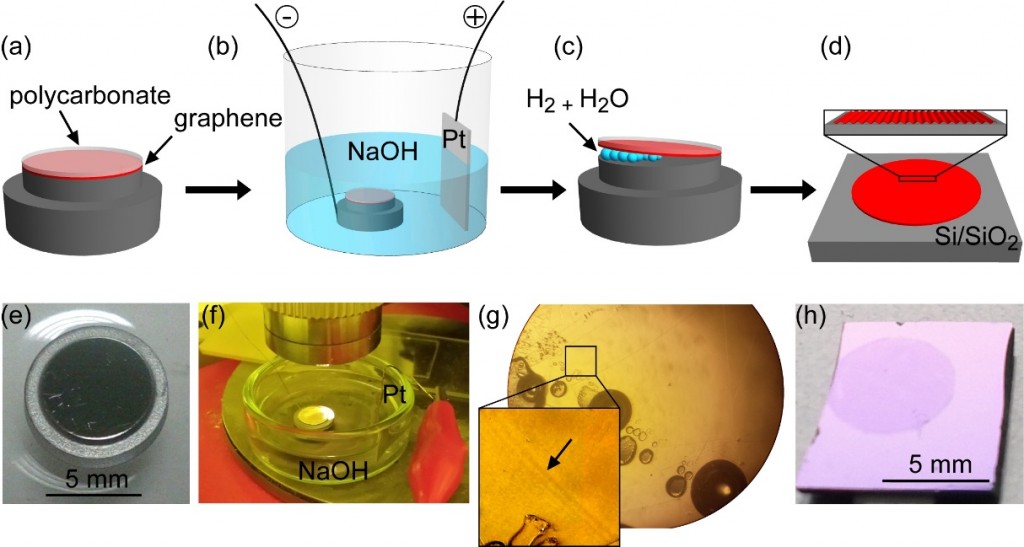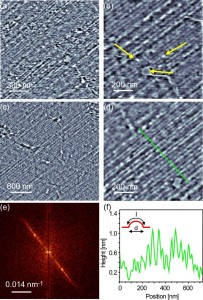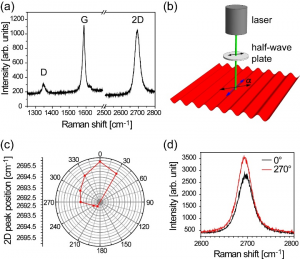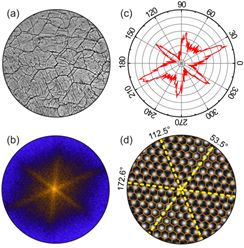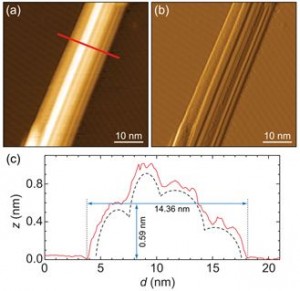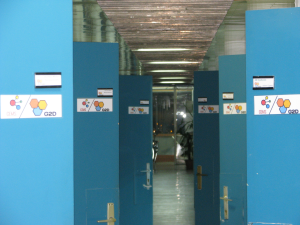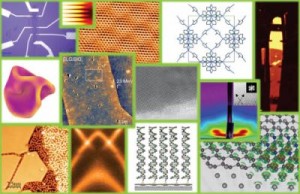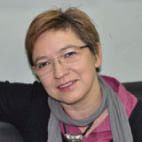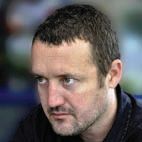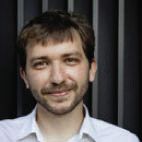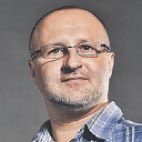Radovi
M. Kralj, Intercalated boosters, Nature Physics 11 (2015) 11–12
J. Feng, K. Liu, M. Graf, M. Lihter, R. D. Bulushev, D. Dumcenco, D.T.L. Alexander, D. Krasnozhon, T. Vuletić, A. Kis, A. Radenovic, Electrochemical Reaction in Single Layer MoS2: Nanopores Opened Atom by Atom // Nano Letters 15 (2015) 3431–3438
T. Borzda, C. Gadermaier, N. Vujičić, et al., Charge Photogeneration in Few-Layer MoS2 // Advanced Functional Materials 25 (2015) 3351–3358
M. Petrović, J.T. Sadowski, A. Šiber, M. Kralj, Wrinkles of graphene on Ir(111): Macroscopic network ordering and internal multi-lobed structure // Carbon 94 (2015) 856–863
Self-assembly of Ge quantum dots on periodically corrugated Si surfaces, M. Buljan, S. Facsko, I. Delač Marion, V. Mikšić Trontl, M. Kralj, M. Jerčinović, C. Baehtz, A. Muecklich, V. Holy, N. Radić, J. Grenzer // Applied Physics Letters 107 (2015) 203101
I. Šrut Rakić, D. Čapeta, M. Plodinec, and M. Kralj, Large-scale transfer and characterization of macroscopic periodically nano-rippled graphene // Carbon 96, 243–249 (2016)
I. Šrut Rakić, M. Kralj, W. Jolie, P. Lazić, W. Sun, J. Avila, M.-C. Asensio, F. Craes, V. Mikšić Trontl, C. Busse, and P. Pervan, Step-induced faceting and related electronic effects for graphene on Ir(332) // Carbon 110, 267–277 (2016)
F. H. Farwick zum Hagen, D. M. Zimmermann, C. C. Silva, C. Schlueter, N. Atodiresei, W. Jolie, A. J. Martínez-Galera, D. Dombrowski, U. A. Schröder, M. Will, P. Lazić, V. Caciuc, S. Blügel, T.-L. Lee, T. Michely, and C. Busse, Structure and Growth of Hexagonal Boron Nitride on Ir(111) // ACS Nano 10, 11012–11026 (2016)
P. Lazić, K. D. Belashchenko, and I. Žutić, Effective gating and tunable magnetic proximity effects in two-dimensional heterostructures // Physical Review B 93, 241401 (2016)
D. Vella, V. Vega-Mayoral, C. Gadermaier, N. Vujičić, T. Borzda, P. Topolovsek, M. Prijatelj, I. Tempra, E. A. A. Pogna, and G. Cerullo, Femtosecond spectroscopy on MoS2 flakes from liquid exfoliation: surfactant independent exciton dynamics // Journal of Nanophotonics 10, 012508 (2016)
T. Car, N. Nekić, M. Jerčinović, K. Salamon, I. Bogdanović-Radović, I. Delač Marion, J. Dasović, G. Dražić, M. Ivanda, and S. Bernstorff, Closely packed Ge quantum dots in ITO matrix: influence of Ge crystallization on optical and electrical properties // Materials Research Express 3, 065003 (2016)
V. Vega-Mayoral, D. Vella, T. Borzda, M. Prijatelj, I. Tempra, E. A. A. Pogna, S. Dal Conte, P. Topolovsek, N. Vujičić, G. Cerullo, D. Mihailovic, and C. Gadermaier, Exciton and charge carrier dynamics in few-layer WS2 // Nanoscale 8, 5428–5434 (2016)
A. Šiber, Shapes of minimal-energy DNA ropes condensed in confinement, Scientific Reports 6 // 29012 (2016)
I. Kaminer, Y. Tenenbaum Katan, H. Buljan, Y. Shen, O. Ilic, J. J. Lopez, L. J. Wong, J. D. Joannopoulos, and M. Soljačić, Efficient plasmonic emission by the quantum Čerenkov effect from hot carriers in graphene // Nature Communications 7, 11880 (2016)
U.A. Schroeder, M. Petrović, T. Gerber, A.J. Martinez-Galera, E. Granas, M.A. Arman, C. Herbig, J. Schnadt, M. Kralj, J. Knudsen, and T. Michely, Core level shifts of intercalated graphene // 2D Materials 4, 015013 (2017)
D. Dombrowski, W. Jolie, M. Petrovic, S. Runte, F. Craes, J. Klinkhammer, M. Kralj, P. Lazic, E. Sela, C. Busse, Energy dependent chirality effects in quasi free-standing graphene // Physical Review Letters 118, 116401 (2017)
M Petrović, U Hagemann, M Horn-von Hoegen, FJM zu Heringdorf, Microanalysis of single-layer hexagonal boron nitride islands on Ir (111) // Applied Surface Science 420, 504 (2017)
M. Petrović, P. Lazic, S. Runte, T. Michely, C. Busse, M. Kralj, Moire-regulated self-assembly of cesium adatoms on epitaxial graphene // Physical Review B 96, 085428, (2017)
J.M. Marmolejo-Tejada, K Dolui, P Lazić, P.H. Chang, S Smidstrup, D Stradi, K. Stokbro, B.K. Nikolic, Proximity band structure and spin textures on both sides of topological-insulator/ferromagnetic-metal interface and their charge transport probes // Nano Letters 17, 5626-5633 (2017)
X Lin, I Kaminer, X Shi, F Gao, Z Yang, Z Gao, H Buljan, JD Joannopoulos, M. Soljačić, H. Chen, B. Zhang, Splashing transients of 2D plasmons launched by swift electrons // Science advances 3, e1601192 (2017)
J. Hall, B. Pielić, C. Murray, W. Jolie, T. Wekking, C. Busse, M. Kralj, T. Michely, Molecular beam epitaxy of quasi-freestanding transition metal disulphide monolayers on van der Waals substrates: A growth study // 2D Materials 5, 025005 (2018)
N. Saigal, I. Wielert, D. Čapeta, N. Vujičić, B.V. Senkovskiy, M. Hell, M. Kralj, and A. Grüneis, Effect of lithium doping on the optical properties of monolayer MoS2 // Appl. Phys. Lett. 112, 121902 (2018)
I. Niehues, A. Blob, T. Stiehm, R. Schmidt, V. Jadriško, B. Radatović, D. Čapeta, M. Kralj, S. Michaelis de Vasconcellos, and R. Bratschitsch, Strain transfer across grain boundaries in MoS2 monolayers grown by chemical vapor deposition // 2D Materials 5, 031003 (2018)
T. Klačić, K. Varga, M. Kralj, I. Delač Marion, H. Vančik, and I. Biljan, Insights into the self-assembly of aromatic dinitroso derivatives on gold surface // Colloids and Surfaces A 552, 110–117 (2018)
I. Delač Marion, D. Čapeta, B. Pielić, F. Faraguna, A. Gallardo, P. Pou, B. Biel, N. Vujičić, and M. Kralj, Atomic-scale defects and electronic properties of a transferred synthesized MoS2 monolayer // Nanotechnology 29, 305703 (2018)
H. Yang, H. Guan, N. Biekert, G. Arefe, D.C. Chang, Y. Sun, P-C. Yeh, X. Liu, S-Y. Hong, I. Delač Marion, M. Kralj, J.C. Hone, R.M. Osgood, Jr., and J.I. Dadap, Layer dependence of third-harmonic generation in thick multilayer graphene // Physical Review Materials 2, 071002(R) (2018)
J. Cai, W. Jolie, C.C. Silva, M. Petrović, C. Schlueter, T. Michely, M. Kralj, T-L. Lee, C. Busse, Modifying the geometric and electronic structure of hexagonal boron nitride on Ir(111) by Cs adsorption and intercalation // Physical Review B 98, 195443 (2018)
M. Petrović, M. Horn-von Hoegen, F.-J. Meyer zu Heringdorf, Lateral heterostructures of hexagonal boron nitride and graphene: BCN alloy formation and microstructuring mechanism // Applied Surface Science 455, 1086 (2018)
P. Lazić, M. Pinterić, D. Rivas Góngora, A. Pustogow, K. Treptow, T. Ivek, O. Milat, B. Gumhalter, N. Došlić, M. Dressel, and S. Tomić, Importance of van der Waals interactions and cation-anion coupling in an organic quantum spin liquid // Physical Review B 97, 245134 (2018)
J. Feng, H. Deschout, S. Caneva, S. Hofmann, I. Lončarić, P. Lazić, A. Radenovic, Imaging of Optically Active Defects with Nanometer Resolution // Nano Letters 18, 1739-1744 (2018)
M. Plodinec, I. Grčić, M. G. Willinger, A. Hammud, X. Huang, I. Panžić, A. Gajović, Black TiO2 nanotube arrays decorated with Ag nanoparticles for enhanced visible-light photocatalytic oxidation of salicylic acid // Journal of Alloys and Compounds 776, 883-896 (2018)
S. Lukin, M. Tireli, I. Lončarić, D. Barišić, P. Šket, D. Vrsaljko, M. di Michiel, J. Plavec, K. Užarević, I. Halasz, Mechanochemical carbon–carbon bond formation that proceeds via a cocrystal intermediate // Chemical Communications 54, 13216-13219 (2018)
D.Novko, Nonadiabatic coupling effects in MgB2 reexamined // Physical Review B 98, 041112(R) (2018)
S.A. Mezzasalma, V. Janicki, K. Salamon, J. Sancho‐Parramon, Combination Law for Drude–Sommerfeld’s Electron Damping in Multilayer Thin Metal Films // Physica Status Solidi (RRL) 12, 1800149 (2018)
N. Krstulović, K. Salamon, O. Budimlija, J. Kovač, J. Dasović, P. Umek, I. Capan, Parameters optimization for synthesis of Al-doped ZnO nanoparticles by laser ablation in water // Applied Surface Science 440, 916-925 (2018)
A. Lošdorfer Božič, A. Šiber, Electrostatics-Driven Inflation of Elastic Icosahedral Shells as a Model for Swelling of Viruses // Biophysical Journal 115, 822 (2018)
D. Novko, J. C. Tremblay, M. Alducin, and J. I. Juaristi, Ultrafast Transient Dynamics of Adsorbates on Surfaces Deciphered: The Case of CO on Cu(100) // Phys. Rev. Lett. 122, 016806 (2019).
I. Lončarić, M. Alducin, J. I. Juaristi, and D. Novko, CO Stretch Vibration Lives Long on Au(111) // J. Phys. Chem. Lett. 10, 1043 (2019).
D. Novko, Q. Zhang, and P. Kaghazchi, Nonadiabatic Effects in Raman Spectra of AlCl−4-graphite Based Batteries // Phys. Rev. Applied 12, 024016 (2019).
V. Despoja, D. Novko, I. Lončarić, N. Golenić, L. Marušić, and V. M. Silkin, Strong acoustic plasmons in chemically doped graphene induced by a nearby metal surface // Phys. Rev. B 100, 195401 (2019).
D. Novko, M. Kralj. Phonon-assisted processes in the ultraviolet-transient optical response of graphene // npj 2D Materials and Applications 3, 48 (2019).
S. Pecqueur, I. Lončarić, V. Zlatić, D. Vuillaume and Ž. Crljen, The non-ideal organic electrochemical transistors impedance // Org. Electron. 71, 14–23 (2019).
E. Mervinetsky, I. Alshanski, J. Buchwald, A. Dianat, I. Lončarić, P. Lazić, Ž. Crljen, R. Gutierrez, G. Cuniberti, M. Hurevich and S. Yitzchaik, Direct Assembly and Metal-Ion Binding Properties of Oxytocin Monolayer on Gold Surfaces // Langmuir 35, 11114–11122 (2019).
L. Kanižaj, K. Molčanov, F. Torić, D. Pajić, I. Lončarić, A. Šantić and M. Jurić, Ladder-like [CrCu] coordination polymers containing unique bridging modes of [Cr(C 2 O 4 ) 3 ] 3− and Cr 2 O 7 2− // Dalt. Trans. 48, 7891–7898 (2019).
B. Karadeniz, D. Žilić, I. Huskić, L. S. Germann, A. M. Fidelli, S. Muratović, I. Lončarić, M. Etter, R. E. Dinnebier, D. Barišić, N. Cindro, T. Islamoglu, O. K. Farha, T. Friščić and K. Užarević, Controlling the Polymorphism and Topology Transformation in Porphyrinic Zirconium Metal–Organic Frameworks via Mechanochemistry // J. Am. Chem. Soc. 141, 19214–19220 (2019).
T. L. Leung, H. W. Tam, F. Z. Liu, J. Y. Lin, A. M. C. Ng, W. K. Chan, W. Chen, Z. B. He, I. Lončarić, L. Grisanti, C. Ma, K. S. Wong, Y. S. Lau, F. R. Zhu, Ž. Skoko, J. Popović, A. B. Djurišić, Mixed Spacer Cation Stabilization of Blue-Emitting n=2 Ruddlesden–Popper Organic-Inorganic Halide Perovskite Films // Adv. Opt. Mater, 1901679 (2019).
R. Scholz, S. Lindner, I. Lončarić, J.C. Tremblay, J.I. Juaristi, M. Alducin, P. Saalfrank, Vibrational response and motion of carbon monoxide on Cu(100) driven by femtosecond laser pulses: Molecular dynamics with electronic friction // Phys. Rev. B 100, 245431 (2019).
M. Petrović, M. Horn-von Hoegen, F.-J. Meyer zu Heringdorf. Equilibrium shape of single-layer hexagonal boron nitride islands on iridium // Scientific Reports 9, 19553 (2019).
A. Selmani, J. Lützenkirchen, K. Kučanda, D. Dabić, E. Redel, I. Delač Marion, D. Kralj, D Domazet Jurašin, M. Dutour Sikirić, Tailoring the stability/aggregation of one- dimensional TiO2(B)/titanate nanowires using surfactants // Beilstein Journal of Nanotechnology 10, 1024-1037 (2019)
A. Jurov, D. Popović, I. Šrut Rakić, I. Delač Marion, G. Filipič, J. Kovač, U. Cvelbar, N. Krstulović, Atmospheric pressure plasma jet–assisted impregnation of gold nanoparticles into PVC polymer for various applications // International journal of Advanced Manufacturing Technology 101, 927-938 (2019)
N. Martín-González, M. Hernando-Pérez, G.N. Condezo, M. PérezIllana, A. Šiber, D. Reguera, P. Ostapchuk, P. Hearing, C. San Martín, P. J. de Pablo, Adenovirus major core protein condenses DNA in clusters and bundles, modulating genome release and capsid internal pressure // Nucl. Acids Res. 47, 9231 (2019).
M. Kokalj Ladan, P. Ziherl, A. Šiber, Topology of dividing planar tilings: Mitosis and order in epithelial tissues // Phys. Rev. E 100, 012410 (2019)
K Salamon, P Dubček, G Dražić, S Bernstorff, N Radić, Lateral inhomogeneities in W/C multilayer mirrors // Thin Solid Films 691, 137611 (2019)
L Basioli, K Salamon, M Tkalčević, I Mekterović, S Bernstorff, M Mičetić, Application of GISAXS in the Investigation of Three-Dimensional Lattices of Nanostructures // Crystals 9, 479 (2019)
N. Nekić, I. Šarić, K. Salamon, L. Basioli, J. Sancho-Parramon, J. Grenzer, R. Hübner, S. Bernstorff, M. Petravić, M. Mičetić, Preparation of non-oxidized Ge quantum dot lattices in amorphous Al2O3, Si3N4 and SiC matrices // Nanotechnology 30, 335601 (2019)
K Salamon, M Mičetić, J Sancho-Parramon, I Bogdanović Radović, Z Siketić, I Šarić, M Petravić, S Bernstorff, β-TaON thin films: production by reactive magnetron sputtering and the question of non-stoichiometry // J. Phys. D: Appl. Phys. 52, 305304 (2019)
J Sancho-Parramon, B Okorn, K Salamon, V Janicki, Plasmonic resonances in copper island films // Applied Surface Science 463, 847-853 (2019)
I. Panžić, K. Juraić, N. Krstulović, A. Šantić, D. Belić, D. Blažeka, M. Plodinec, V. Mandić, J. Macan, A. Hammud, D. Ivanov, J. Plaisier, M. G. Willinger, D. Gracin, A. Gajović, ZnO@ TiO2 Core Shell Nanorod Arrays with Tailored Structural, Electrical, and Optical Properties for Photovoltaic Application // Molecules 24, 3965 (2019)
M. Plodinec, I. Grčić, M. G. Willinger, A. Hammud, X. Huang, I. Panžić, A. Gajović, Black TiO2 nanotube arrays decorated with Ag nanoparticles for enhanced visible-light photocatalytic oxidation of salicylic acid // Journal of Alloys and Compounds 776, 883-896 (2019)
J. Macan, M. Ivanko, I. Bukovčan, I. Grčić, A. Gajović, Stable hierarchical ZnO structures for photocatalytic degradation of 2, 5-dihydroxybenzoic acid // Materials Science in Semiconductor Processing 97, 48-55 (2019)
Z. Torbatian, D. Novko, R. Asgari, Tunable low-loss hyperbolic plasmon polaritons in a Td-WTe2 single layer // Phys. Rev. Applied 14, 044014 (2020).
Z. Torbatian, M. Alidoosti, D. Novko, R. Asgari, Low-loss two-dimensional plasmon modes in antimonene // Phys. Rev. B 101, 20541 (2020).
D. Novko, F. Caruso, C. Draxl, E. Cappelluti Ultrafast Hot Phonon Dynamics in MgB2 Driven by Anisotropic Electron-Phonon Coupling // Phys. Rev. Lett. 124, 077001 (2020).
D. Novko, Broken adiabaticity induced by Lifshitz transition in MoS2 and WS2 single layers // Commun. Phys. 3, 30 (2020).
F. Caruso, D. Novko, C. Draxl, Photoemission signatures of nonequilibrium carrier dynamics from first principles // Phys. Rev. B 101, 035128 (2020).
T.L. Leung, H.W. Tam, F. Liu, J. Lin, A.M.C. Ng, W.K. Chan, W. Chen, Z. He, I. Lončarić, L. Grisanti, Mixed Spacer Cation Stabilization of Blue‐Emitting n= 2 Ruddlesden–Popper Organic–Inorganic Halide Perovskite Films // Advanced Optical Materials, 8, 1901679, (2020).
Y. Yuan, K. Sheng, S. Zeng, X. Han, L. Sun, I. Lončarić, W. Zhan, D. Sun, Engineering Cu/TiO2@ N-Doped C Interfaces Derived from an Atom-Precise Heterometallic CuII4TiIV5 Cluster for Efficient Photocatalytic Hydrogen Evolution // Inorganic Chemistry, 59, 8, 5456-5462, (2020).
H.W. Tam, T.K. Leung, W. Sun, F. Liu, C. Ma, K.S. Wong, I. Lončarić, L. Grisanti, J. Ovčar, Ž. Skoko, Phase control for quasi-2D blue emitters by spacer cation engineering // Journal of Materials Chemistry C, 8, 11052-11060, (2020).
S. Lukin, T. Stolar, I. Lončarić, I. Milanović, N. Biliškov, M. di Michiel, T. Friščić, I. Halasz, Mechanochemical Metathesis between AgNO3 and NaX (X= Cl, Br, I) and Ag2XNO3 Double-Salt Formation // Inorganic Chemistry, 59, 17, 12200–12208, (2020).
M. Bosnar, V. Caciuc, N. Atodiresei, I. Lončarić, S. Blügel, Se intercalation between PtSe2 and Pt surface in synthesis of PtSe2 by direct selenization of Pt surface // Physical Review B 102, 115427 (2020).
M. Bosnar, I. Lončarić, P. Lazić, K.D. Belashchenko, I. Žutić, Proximity-induced magnetization in graphene: Towards efficient spin gating // Physical Review Materials 4, 114006 (2020).
L. Kanižaj, D. Barišić, F. Torić, D. Pajić, K. Molčanov, A. Šantić, I. Lončarić, M. Jurić, Structural, Electrical, and Magnetic Versatility of the Oxalate-Based [CuFe] Compounds Containing 2,2′:6′,2″-Terpyridine: Anion-Directed Synthesis // Inorganic Chemistry 59, 18078–18089 (2020).
V. Martinez, B. Karadeniz, N. Biliškov, I. Lončarić, S. Muratović, D. Žilić, S.M. Avdoshenko, M. Roslova, A.A. Popov, K. Užarević, Tunable Fulleretic Sodalite MOFs: Highly Efficient and Controllable Entrapment of C60 Fullerene via Mechanochemistry // Chemistry of Materials 32, 10628–10640 (2020).
S. Tanaka, T. Yoshida, K. Watanabe, Y. Matsumoto, T. Yasuike, M. Petrović, M. Kralj, Linewidth Narrowing with Ultimate Confinement of an Alkali Multipole Plasmon by Modifying Surface Electronic Wave Functions with Two-Dimensional Materials // Physical Review Letters 125, 126802 (2020).
T. Yoshida, K. Watanabe, M. Petrović, and Marko Kralj, Anomalous temperature Dependence of Exciton Spectral Diffusion in Tetracene Thin Film // The Journal of Physical Chemistry Letters 11, 5248 (2020).
B. Pielić, J. Hall, V. Despoja, I. Šrut Rakić, M. Petrović, A. Sohani, C. Busse, T. Michely, M. Kralj, Sulfur structures on bare and graphene-covered Ir(111) // The Journal of Physical Chemistry C 124, 6659 (2020).
T. Hartl, M. Will, D. Čapeta, R. Singh, D. Scheinecker, V.B. de la Cruz, S. Dellmann, P. Lacovig, S. Lizzit, B.V. Senkovskiy, A. Grüneis, M. Kralj, J. Knudsen, J. Kotakoski, T. Michely, P. Bampoulis, Cluster Superlattice Membranes // ACS Nano 14, 13629-13637 (2020).
I. Grčić, A. Gajović, M. Plodinec, K. Šimunković, H. Ivanković, M.-G. Willinger, Enhanced Visible-Light Driven Photocatalytic Activity of Ag@TiO2 Photocatalyst Prepared in Chitosan Matrix // Catalysts 10(7), 763 (2020).
T. Čižmar, V. Kojić, M. Rukavina, L. Brkljačić, K. Salamon, I. Grčić, L. Radetić, A. Gajović, Hydrothermal Synthesis of FeOOH and Fe2O3 Modified Self-Organizing Immobilized TiO2 Nanotubes for Photocatalytic Degradation of 1H-Benzotriazole // Catalysts 10, 1371 (2020).
T. Čižmar, I. Panžić, K. Salamon, I. Grčić, L. Radetić, J. Marčec, A. Gajović, Low-cost synthesis of Cu-modified immobilized nanoporous TiO2 for photocatalytic degradation of 1H-benzotriazole // Catalysts 10, 19 (2020).
J. Macan, F. Brleković, S. Kralj, A. Supina, D. Gracin, A. Šantić, A. Gajović, Soft chemistry synthesis of CaMnO3 powders and films // Ceramics International 46, 18200–18207 (2020).
I. Erceg, A. Selmani, A. Gajović, I. Panžić, D. Iveković, F. Faraguna, S. Šegota, M. Ćurlin, V. Strasser, J. Kontrec, D. Kralj, N. Maltar Strmečki, M. Dutor Sikirić, Calcium phosphate formation on TiO2 nanomaterials of different dimensionality // Colloids and Surfaces A: Physicochemical and Engineering Aspects 593, 124615 (2020).
L. Basioli, M. Tkalčević, I. Bogdanović-Radović, G. Dražić, P. Nadazdy, P. Siffalovic, K. Salamon, M. Mičetić, 3D Networks of Ge Quantum Wires in Amorphous Alumina Matrix // Nanomaterials 10, 1363 (2020).
J. Macan, M. Dutour Sikirić, M. Deluca, R. Bermejo, C. Baudin, M. Plodinec, K. Salamon, M. Čeh, A. Gajović, Mechanical properties of zirconia ceramics biomimetically coated with calcium deficient hydroxyapatite // Journal of the Mechanical Behavior of Biomedical Materials 111, 104006 (2020).
M. Tkalčević, L. Basioli, K. Salamon, I. Šarić, J. Sancho-Parramon, M. Bubaš, I. Bogdanović-Radović, S. Bernstorff, Z. Fogarassy, K. Balázsi, M. Petravić, M. Mičetić, Ge quantum dot lattices in alumina prepared by nitrogen assisted deposition: Structure and photoelectric conversion efficiency // Solar Energy Materials and Solar Cells 218, 110722 (2020).
L. Basioli, J. Sancho-Parramon, V. Despoja, S. Fazinić, I. Bogdanović Radović, I. Božićević Mihalić, K. Salamon, N. Nekić, M. Ivanda, G. Dražić, S. Bernstorff, G. Aquilanti, M. Mičetić, Ge Quantum Dots Coated with Metal Shells (Al, Ta, and Ti) Embedded in Alumina Thin Films for Solar Energy Conversion // ACS Applied Nano Materials 3, 8640–8650 (2020).
M. Jakovac, T. Klaser, B. Radatović, Ž. Skoko, L. Pavić, M. Žic, Surface Characterization and Conductivity of Two Types of Lithium-Based Glass Ceramics after Accelerating Ageing // Materials 13, 5632 (2020).
T. Mihelj Josipović, M. Kovačević, S. Mateša, M. Kostešić, N. Matijaković, B. Radatović, D.M. Lyons, D. Kralj, M. Dutour Sikirić, The Influence of Different Classes of Amino Acids on Calcium Phosphates Seeded Growth // Materials 13, 4798 (2020).
M. Kralj, A. Supina, D. Čapeta, I. Sović, I. Halasz, Mechanochemical oxidation of graphite for graphene-hydrogel applications: Pitfalls and benefits // Materialia 14, 100908 (2020).
A. Božič and A. Šiber, Mechanical design of apertures and the infolding of pollen grain // Proc Natl Acad Sci USA 117, 26600 (2020).
A. Šiber, “Icosadeltahedral Geometry of Geodesic Domes, Fullerenes and Viruses: A Tutorial on the T-Number” // Symmetry 12, 556 (2020).
M. Tkalčević, M. Gotić, L. Basioli, M. Lihter, G. Dražić, S. Bernstorff, T. Vuletić, M. Mičetić, Deposition of Thin Alumina Films Containing 3D Ordered Network of Nanopores on Porous Substrates // Materials 13, 2883 (2020).
A. Selmani, L. Ulm, K. Kasemets, I. Kurvet, I. Erceg, R. Barbir, B. Pem, P. Santini, I. Delač Marion, T. Vinković, A. Krivohlavek, M. Dutour Sikirić, A. Kahru, I. Vinković Vrček, Stability and toxicity of differently coated selenium nanoparticles under model environmental exposure settings // Chemosphere 250, 126265 (2020).
Pozvana konferencijska predavanja
Chemical and mechanical nanoengineering of (epitaxial) graphene, M. Kralj @ Energy Materials and Nanotechnology Qingdao Meeting, Qingdao, China (14.-17.6.2015.)
Epitaksijalni grafen i srodni 2D materijali, M. Kralj @ 9. znanstveni sastanak Hrvatskog fiziklanog društva, Umag, Croatia (5.-7.10.2015.)
Graphene Applications, M. Kralj @ Inovation – Driven Defence Enterprising, Zagreb, Croatia (19.-20.10.2015.)
Odabrani seminari i kolokviji
Chemical and mechanical engineering of epitaxial graphene, 25.3.2015, talk by M. Kralj at Physik-Institut, University of Zurich, Zurich, Switzerland (invited by Thomas Greber)
Engineering epitaxial graphene by adsorption, intercalation and strain, 3.6.2015, talk by M. Kralj at NUS Centre for Advanced 2D Materials, National University of Singapore, Singapore (invited by Slaven Garaj)
Aspects of epitaxial graphene engineering: adsorption, intercalation, strain, and transfer, 10.6.2015, talk by M. Kralj at Institute of Physics, Chinese Academy of Sciences, Beijing, China (invited by Hongjun Gao / Ye-Liang Wang)
Primjene epitaksijalnog grafena: adsorpcija, interkalacija, elastičnost, 13.07.2015., talk by M. Kralj at Mediterranean Institute for Life Sciences, Split, Croatia (invited by Vlasta Bonačić-Koutecky)

